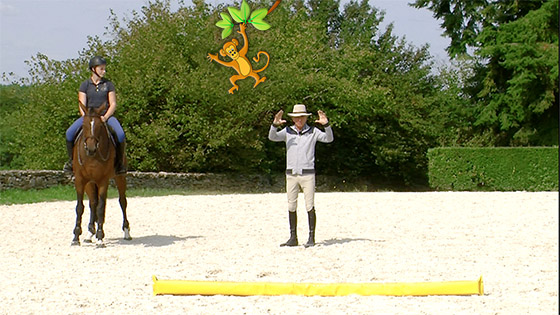Harmony and confidence approaching fences

Being able to master and control your mind and thoughts in front of a fence is the goal of this exercise. To learn how to use your eyes during all the phases of a jump, is the fastest and most effective way to stay in the present moment physically and mentally...
The control of our mind when approaching a jump is one of the biggest challenge for most jumpers. We know how much the control of the mind influences the physical behaviour of the rider which in turn, influences the behaviour of the horse. How well the horse jumps is not just a technicality. Any riders, even the best of the best, experience it on a regular basis. When the mind is not present, the body won’t follow….nor will the horse’s body. The off-topic thoughts such as doubt, worrisome, fear…are the spiral event to failure: a fault, a refusal, a fall.
Any rider should be able to set a training plan to renew with confidence and therefore be able to use fully the technical knowledge. It’s one of the fundamental of Michel Robert’s training method. If you’ve been following the “Training” program, you are aware of the fundamental of the ideal position; the one that will allow your body to work and act in relaxation while being in synchrony with your horse’s movements. This harmony that you’re able to reach when working on the flat, needs to be maintained when jumping. In this video, we are discovering how to reach it, with a very simple exercise that will, nonetheless, require you to be self-disciplined with a great determination.
Being able to master and control your mind and thoughts in front of a fence is the goal of this exercise. To learn how to use your eyes during all the phases of a jump, is the fastest and most effective way to stay in the present moment physically and mentally. Of course, it requires a little bit of practice. To look down and stare at the trouble spot such as the base of the fence, is a natural and difficult to get rid of, instinct.
This exercise that seems so simple, can in fact be very challenging for some of us.
Ideally, you would get the help of a ground person who can watch closely your attitude and tell you when your eyes look down. It’s really important as, we riders, aren’t aware of these little glances down which however have a significant negative impact especially when approaching jumps. The simple fact of looking down, will influence negatively the rider’s position, and therefore, his balance and then the motion of the horse….The list of the negative results is quite long. If there absolutely no positive point into looking down, there is on the other hand only benefits from looking up and far…..So why not take advantage of it?
This exercise is linked to the sheet M1 of the booklet Training program 1

